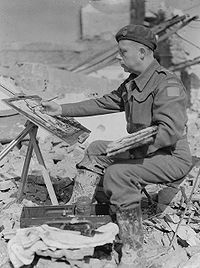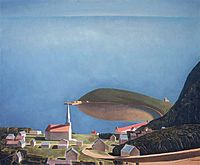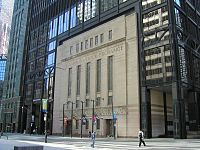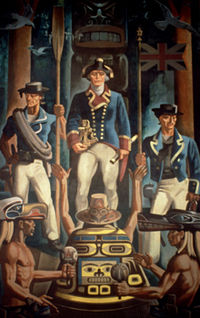- Charles Comfort
-
Charles Comfort 
Comfort painting in the area around Ortona, Italy, on duty as a WWII war artist.Born 22 July 1900
Edinburgh, ScotlandDied June 5, 1994 (aged 93)
Ottawa, Ontario, CanadaNationality Canadian Field Painting Works Captain Vancouver, 1937, Tadoussac, 1935. Influenced by Charles Sheeler, Robert Henri Awards Order of Canada, 1972 Charles Fraser Comfort, OC (1900 – July 5, 1994) was a Canadian painter, sculptor, teacher, writer and administrator.
Contents
Career and biography
Early life
Born near Edinburgh, Scotland, Comfort moved to Winnipeg in 1912 with his family. His father found work with the treasury department for the city of Winnipeg. Comfort as the eldest child had to work from a young age to help support his family.[1] The following year he began work as a commercial artist at Brigden (St. Clair, Ontario)’s Studio in Winnipeg, and by 1916 Comfort started attending evening classes at the Winnipeg School of Art.
Comfort saved money to attend the Art Students League of New York under Robert Henri and Euphrasius Tucker. Still working part-time for Brigden's commercial studio, he was temporarily transferred to Toronto in 1919. While in Toronto, Comfort joined the Arts and Letters Club, taking life-study classes and meeting members of the Group of Seven. Comfort visited the Group’s inaugural 1920 exhibition, which inspired Comfort to work on landscape paintings, a theme he continued throughout his lifetime.[2]
Comfort returned to Winnipeg in 1922 for his first exhibition of watercolours at the Winnipeg Art Gallery. During this time, he met LeMoine Fitzgerald and Walter J. Phillips. It was not until 1925 that Comfort painted his first oil painting, when he returned to Toronto where he befriended Will Ogilvie, who may have influenced this switch to oil.[2] In 1928 he painted a striking watercolour portrait of violinist Alexander Chuhaldin with his Amati violin, with a copy of the Natalia Goncharova set design for Le Coq d'Or in the background (painting now in the Art Gallery of Hamilton).[3]
Mid-career and work as a war artist
 Comfort's Tadoussac of 1935.
Comfort's Tadoussac of 1935.
In the 1930s, Comfort regularly worked as a commercial illustrator as well as a teacher at the Ontario College of Art and Design from 1935-1938. He subsequently held by a teaching position at the University of Toronto, a post he continued after the war until 1960.[4] He taught primarily painting techniques, including mural-painting, and other studio courses later in his career at the university.
He was commissioned to design a mural for Toronto’s North American Life Building in 1932, the first in many he completed. The following year he met the American Precisionist Charles Sheeler. One of the artist’s most celebrated works, Tadoussac of 1935, suggests the influence of Sheeler due to its clear crisp colours and shapes.[2]
 Toronto Stock Exchange facade, with Comfort's frieze
Toronto Stock Exchange facade, with Comfort's frieze
In 1936, Comfort rented a studio next to a room occupied by A. Y. Jackson, in the Studio Building, a warehouse made famous by the Group of Seven artists, and the following year he designed the frieze for the Toronto Stock Exchange. Comfort helped initiate Canada’s WWII War Art program and served as an official war artist in World War II, leaving an important body of work that records Canada's war effort abroad. He was one of the organizers of the 1941 Kingston Conference, a meeting of Canadian artists to discuss the role of art in society as well as other issues facing the arts at the time. Furthermore, he was a founding member of the Federation of Canadian Artists and contributed to the 1951 Massey Report, which lead to the founding of the Canada Council. an organization that Comfort helped establish.[2]
Director of National Gallery 1960-65
After the war, Comfort served on the Board of Directors and various committees at the Art Gallery of Toronto, and was Director of the National Gallery of Canada from 1959 until 1965. He was also a founding member of the Canadian Society of Graphic Art, Canadian Society of Painters in Water Colour, and Canadian Group of Painters, and held executive positions in a number of art organizations. He received an honorary doctorate from Mount Allison University in 1958. His extensive involvement during his life with artist's organizations inficates his strong belief in the importance of art integrated within society.[2] In 1972, he was made an Officer of the Order of Canada.
First Nations criticism
The Canadian National Railway commissioned Captain Vancouver for Hotel Vancouver in 1939. After months of research and planning, Comfort decided to depict a hypothetical encounter between Captain George Vancouver and an unnamed Indian chief at a potlatch ceremony. Comfort researched the clothing of the era and consulted Aboriginal anthropologist Dr. Marius Barbeau and others. The painting was removed in 1969 when the hotel was renovated. The wife of Governor General of Canada Roland Michener discovered the work after it was briefly misplaced and donated it to the University of British Columbia. From this time aboriginal viewers have raised concern over the representation of the First Nations people, as Captain Vancouver physically stands triumphantly over the aboriginal men.[5]
In 1997, Kwakiutl artist David Neel made the Captain Vancouver Portrait Mask, a carved mixed-media mask of the captain. Neel made this work to critique the mural and its depiction of First Nations history and society.[6] Also in 1997, Edmonton-based artist Jane Ash Poitras painted a new mural representing the same scene with the intention to critique and re-negotiate Comfort’s depiction of First Nations people. [7]
See also
- Canadian official war artists
- War artist
- War art
Notes
- ^ Gray, 4.
- ^ a b c d e "Cybermuse Artist's Page: Charles F. Comfort". National Gallery of Canada. http://cybermuse.gallery.ca/cybermuse/search/bio_e.jsp?iartistid=1093. Retrieved 2008-11-01.
- ^ Interview with Charles Comfort, 3 October 1973, Canadian Painting in the Thirties Exhibition Records, National Gallery of Canada Fonds, National Gallery of Canada Library and Archives
- ^ Reid, 186-187.
- ^ Gray, 20-22.
- ^ "Telling Stories: Narratives of Nationhood". Confederation Centre Art Gallery. http://www.nationhood.ca/html_en/module_core.cfm?tab=1&modNum=8. Retrieved 2008-11-01.
- ^ MacAndrew, Barbara (23 June 1997). "Native Art Honoured at Festival". The Globe and Mail: Arts Section. p. C1.
References
- "Charles Fraser Comfort (1900-1994)". Library and Archives Canada. Archived from the original on February 26, 2005. http://web.archive.org/web/20050226183053/http://www.collectionscanada.ca/war-artists/05100207_e.html. Retrieved August 8, 2005.
- Charles Fraser Comfort: fifty years Winnipeg: Winnipeg Art Gallery, 1972.
- Charles Fraser Comfort, the war years. Ottawa : Canadian War Museum, 1979.
- Gray, Margaret. Charles Comfort Agincourt, Ontario: Gage Pub., c1976. ISBN 0771599889
- Hughes, Mary Jo. Take Comfort: The Career of Charles Comfort. Winnipeg: Winnipeg Art Gallery, 2007. ISBN 0889152373
- Morse, Jennifer (1 May 2001). "War Art: Charles Comfort". Legion Magazine. http://www.legionmagazine.com/en/index.php/2001/05/charles-comfort/. Retrieved 2009-04-16.
- Reid, Dennis A Concise History of Canadian Painting 2nd Edition. Toronto: Oxford University Press, 1988. ISBN 019540663X.
External links
Categories:- 1900 births
- 1994 deaths
- Canadian painters
- Canadian sculptors
- Canadian architectural sculptors
- Canadian muralists
- Officers of the Order of Canada
- People from Winnipeg
- Scottish painters
- War artists
- Art Students League of New York alumni
- Scottish emigrants to Canada
Wikimedia Foundation. 2010.

